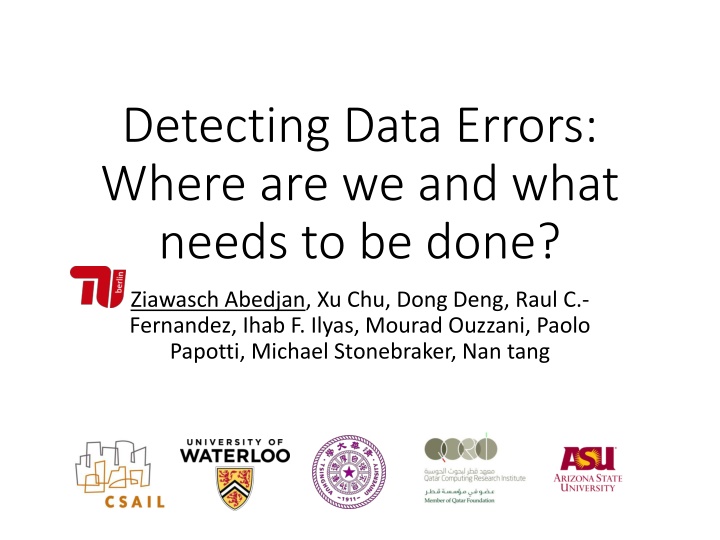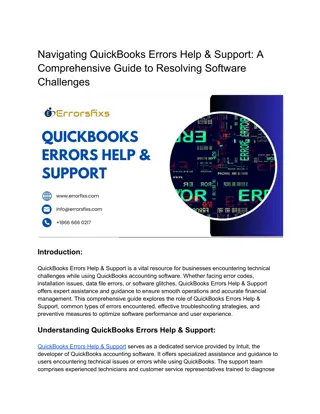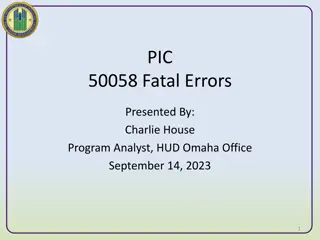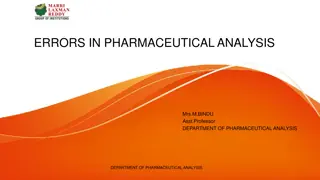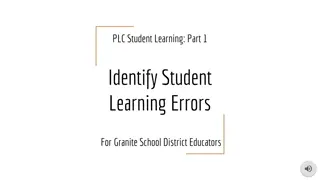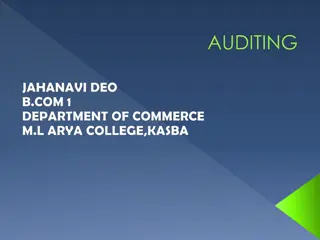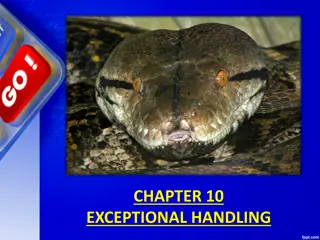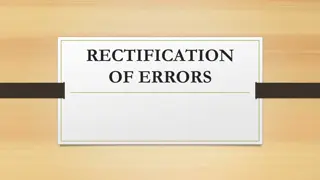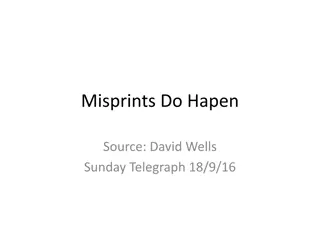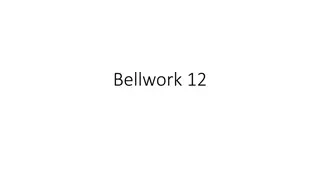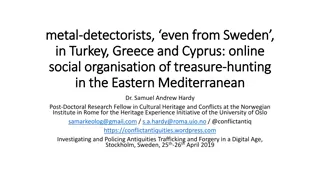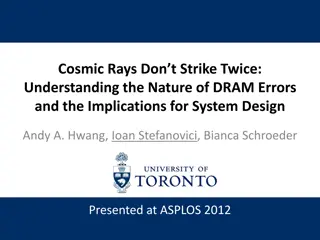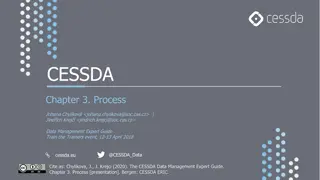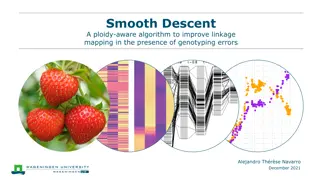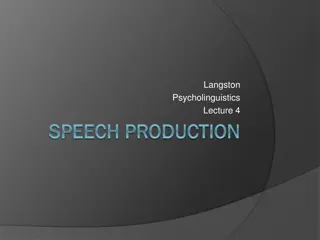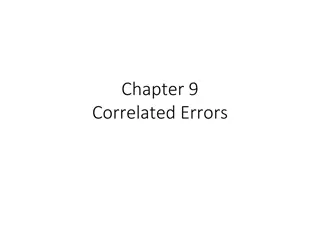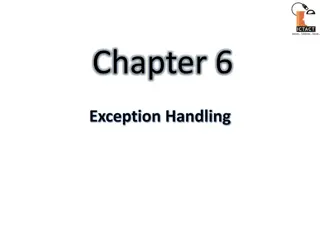Detecting Data Errors: Where Are We and What Needs to Be Done?
Extensive research has been conducted on different cleaning algorithms, evaluating their performance on real-world datasets. This study explores the effectiveness of various error detection techniques, including rule-based algorithms, pattern verification tools, and statistical outlier identification. The research also delves into the impact of enrichment and domain-specific cleaning tools, aiming to understand the current landscape of error detection strategies and their applicability in practical scenarios.
Download Presentation

Please find below an Image/Link to download the presentation.
The content on the website is provided AS IS for your information and personal use only. It may not be sold, licensed, or shared on other websites without obtaining consent from the author.If you encounter any issues during the download, it is possible that the publisher has removed the file from their server.
You are allowed to download the files provided on this website for personal or commercial use, subject to the condition that they are used lawfully. All files are the property of their respective owners.
The content on the website is provided AS IS for your information and personal use only. It may not be sold, licensed, or shared on other websites without obtaining consent from the author.
E N D
Presentation Transcript
Detecting Data Errors: Where are we and what needs to be done? Ziawasch Abedjan, Xu Chu, Dong Deng, Raul C.- Fernandez, Ihab F. Ilyas, Mourad Ouzzani, Paolo Papotti, Michael Stonebraker, Nan tang
Motivation There has been extensive research on many different cleaning algorithms Usually evaluated on errors injected into clean data Which we find unconvincing (finding errors you injected ) How well do current techniques work in the wild ? What about combinations of techniques? This study is not about finding the best tool or better tools! Detecting Data Errors: Where are we and what needs to be done? 2
What we did 1. Ran 8 different cleaning systems on real world datasets and measured effectivity of each single system combined effectivity upper-bound recall 2. Analyzed impact of Enrichment 3. Tried out domain specific cleaning tools Detecting Data Errors: Where are we and what needs to be done? 3
Error Types Literature: [Hellerstein 2008, Ilyas&Chu 2015,Kim et al. 2003, Rahm&Do 2000] General types: Outliers Quantitative Pattern violations Qualitative Duplicates Constraint violations Detecting Data Errors: Where are we and what needs to be done? 4
Error Detection Strategies Rule-based detection algorithms Detecting violation of constraints, such as functional dependencies Pattern verification and enforcement tools Syntactical patterns, such as date formatting Semantical patterns, such as location names Quantitative algorithms Statistical outliers Deduplication Discovering conflicting attribute values in duplicates Detecting Data Errors: Where are we and what needs to be done? 5
Tool Selection Premise: Tool is State-of-the-Art Tool is sufficiently general Tool is available Tool covers at least one of the leaf error types: Detecting Data Errors: Where are we and what needs to be done? 6
5 Data Sets 1. MIT VPF Procurement dataset containing information about suppliers (companies and individuals) Contains names, contact data, and business flags Merck List of IT-services and software Attributes include location, number of end users, business flags Animal Information about random capture of animals, Attributes include tags, sex, weight, etc Rayyan Bib Literature references collected from various sources Attributes include author names, publication titles, ISSN, etc. BlackOak Address dataset that have been synthetically dirtied Contains names, addresses, birthdate, etc. 2. 3. 4. 5. Detecting Data Errors: Where are we and what needs to be done? 7
5 Data Sets continued Dataset # columns # rows Ground truth Errors MIT VPF 42 24K 13k (partial) 6.7% Merck 61 2262 2262 19.7% Animal 14 60k 60k 0.1% Rayyan Bib 11 1M 1k (partial) 35% BlackOak 12 94k 94k 34% Detecting Data Errors: Where are we and what needs to be done? 8
Evaluation Methodology We have the same knowledge as the data owners about the data: Quality constraints, business rules Best effort in using all capabilities of the tools However: No heroics, i.e., embedding custom java code within a tool Precision = ????????? ???????? ?????? ?????? ?? ????? Recall = ????????? ???????? ?????? ???????? ?????? F-Measure = 2 ????????? ?????? ?????????+?????? Detecting Data Errors: Where are we and what needs to be done? 9
Single Tool Performance: MIT MIT VPF P R F Tools DC-Clean .14 .18 .25 Trifacta .86 .90 .94 # columns # rows Ground truth Errors OpenRefine .86 .90 .95 42 24K 13k (partial) 6.7% Pentaho .59 .73 .95 KNIME .86 .90 .95 Gaussian .07 .07 .07 Histogram .11 .12 .13 GMM .29 .19 .14 Katara .01 .02 .40 Tamr .02 .04 .16 .24 Union .93 .38 10 Detecting Data Errors: Where are we and what needs to be done?
Single Tool Performance: Merck Merck P R F Tools # columns # rows Ground truth Errors DC-Clean .99 .78 .87 Trifacta .99 .78 .87 61 2262 2262 19.7% OpenRefine .99 .78 .87 Pentaho .99 .78 .87 KNIME .99 .78 .87 Gaussian .19 .00 .01 Histogram .13 .02 .04 GMM .17 .32 .22 Katara -- -- -- Tamr -- -- -- Union .33 .85 .48 11 Detecting Data Errors: Where are we and what needs to be done?
Single Tool Performance: Animal Animal P R F Tools DC-Clean .12 .53 .20 Trifacta 1.0 .03 .06 # columns # rows Ground truth Errors OpenRefine .33 .001 .20 14 60k 60k 0.1% Pentaho .33 .001 .20 KNIME .33 .001 .20 Gaussian .00 .00 .00 Histogram .00 .00 .00 GMM .00 .00 .00 Katara .55 .04 .07 Tamr -- -- -- Union .13 .58 .21 12 Detecting Data Errors: Where are we and what needs to be done?
Single Tool Performance: Rayyan Rayyan Bib P R F Tools DC-Clean .74 .55 .63 # columns # rows Ground truth Errors Trifacta .71 .59 .65 11 1M 1k (partial) 35% OpenRefine .95 .60 .74 Pentaho .71 .58 .64 KNIME .71 .58 .64 Gaussian .41 .13 .20 Histogram .40 .16 .23 GMM .53 .39 .44 Katara .60 .39 .47 Tamr -- -- -- Union .47 .85 .61 Detecting Data Errors: Where are we and what needs to be done? 13
Single Tool Performance: BlackOak BlackOak P R F Tools DC-Clean .46 .43 .44 Trifacta .96 .93 .94 OpenRefine .99 .95 .97 # columns # rows Ground truth Errors Pentaho 1.0 .66 .79 12 94k 94k 34% KNIME 1.0 .66 .79 Gaussian .91 .73 .81 Histogram .52 .51 .52 GMM .38 .37 .38 Katara .88 .06 .11 Tamr .41 .63 .50 Union .39 .99 .56 Detecting Data Errors: Where are we and what needs to be done? 14
Single Tool Performance MIT VPF P R F Merck P R F Animal P R F Rayyan Bib P R F BlackOak P R F Tools DC-Clean .14 .18 .99 .78 .87 .12 .53 .20 .74 .55 .63 .46 .43 .44 .25 Trifacta .86 .90 .99 .78 .87 1.0 .03 .06 .71 .59 .65 .96 .93 .94 .94 OpenRefine .86 .90 .99 .78 .87 .33 .001 .20 .95 .60 .74 .99 .95 .97 .95 Pentaho .59 .73 .99 .78 .87 .33 .001 .20 .71 .58 .64 1.0 .66 .79 .95 KNIME .86 .90 .99 .78 .87 .33 .001 .20 .71 .58 .64 1.0 .66 .79 .95 Gaussian .07 .07 .19 .00 .01 .00 .00 .00 .41 .13 .20 .91 .73 .81 .07 Histogram .11 .12 .13 .02 .04 .00 .00 .00 .40 .16 .23 .52 .51 .52 .13 GMM .29 .19 .17 .32 .22 .00 .00 .00 .53 .39 .44 .38 .37 .38 .14 Katara .01 .02 -- -- -- .55 .04 .07 .60 .39 .47 .88 .06 .11 .40 Tamr .02 .04 -- -- -- -- -- -- -- -- -- .41 .63 .50 .16 .24 Union .93 .38 .33 .85 .48 .13 .58 .21 .47 .85 .61 .39 .99 .56 Detecting Data Errors: Where are we and what needs to be done? 15
Combined Tool Performance Na ve appraoch k tools agree on a value to be an error Typical precision-recall trade-off Maximum entropy-based order selection: 1. Run tool on samples and verify the results 2. Pick the tool with highest precision (maximum entropy reduction) 3. Verify the results 4. Update precision and recall of other tools accordingly 5. Repeat step 2 Drop tools with precision below 10% Detecting Data Errors: Where are we and what needs to be done? 16
Ordering-based approach Precision and recall depending on different minimum precision thresholds (compared to union) MIT VPF with 39,158 errors Merck with 27,208 errors Detecting Data Errors: Where are we and what needs to be done? 17
Maximum possible recall Manually checked each undetected error and reasoned whether it could have beendetected by a better variant of a tool, e.g. a more sophisticated rule or transformation. Dataset Best effort recall Upper-bound recall Remaining errors MIT VPF 0.92 0.98 (+1,950) 798 Merck 0.85 0.99 (+4,101) 58 Animal 0.57 0.57 592 Rayyan Bib 0.85 0.91 (+231) 347 BlackOak 0.99 0.99 75 Detecting Data Errors: Where are we and what needs to be done? 18
Enrichment and Domain-specific tools Enrichment Manually appended more columns through joining to other tables of the database Improves performance of rule-based and duplicate detection systems Domain-specific tool: Used a commercial address cleaning service High precision on the specific domain But did not lead to the increase of overall recall Detecting Data Errors: Where are we and what needs to be done? 19
Conclusions (1) There is no single dominant tool. (2) Improving individual tools has marginal benefit. We need a combination of tools (3) Picking the right order in applying the tools can improve the precision and help reduce the cost of validation by humans. (4) Domain specific tools can achieve on average high precision and recall compared to general-purpose tools. (5) Rule-based systems and duplicate detection benefited from data enrichment. Detecting Data Errors: Where are we and what needs to be done? 20
Future Directions (1) More reasoning on holistic combination of tools (2) Data enrichment can benefit cleaning (3) Interactive dashboard (4) More reasoning on real-world data Detecting Data Errors: Where are we and what needs to be done? 21
